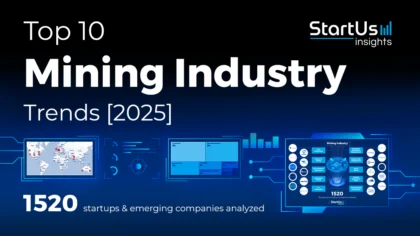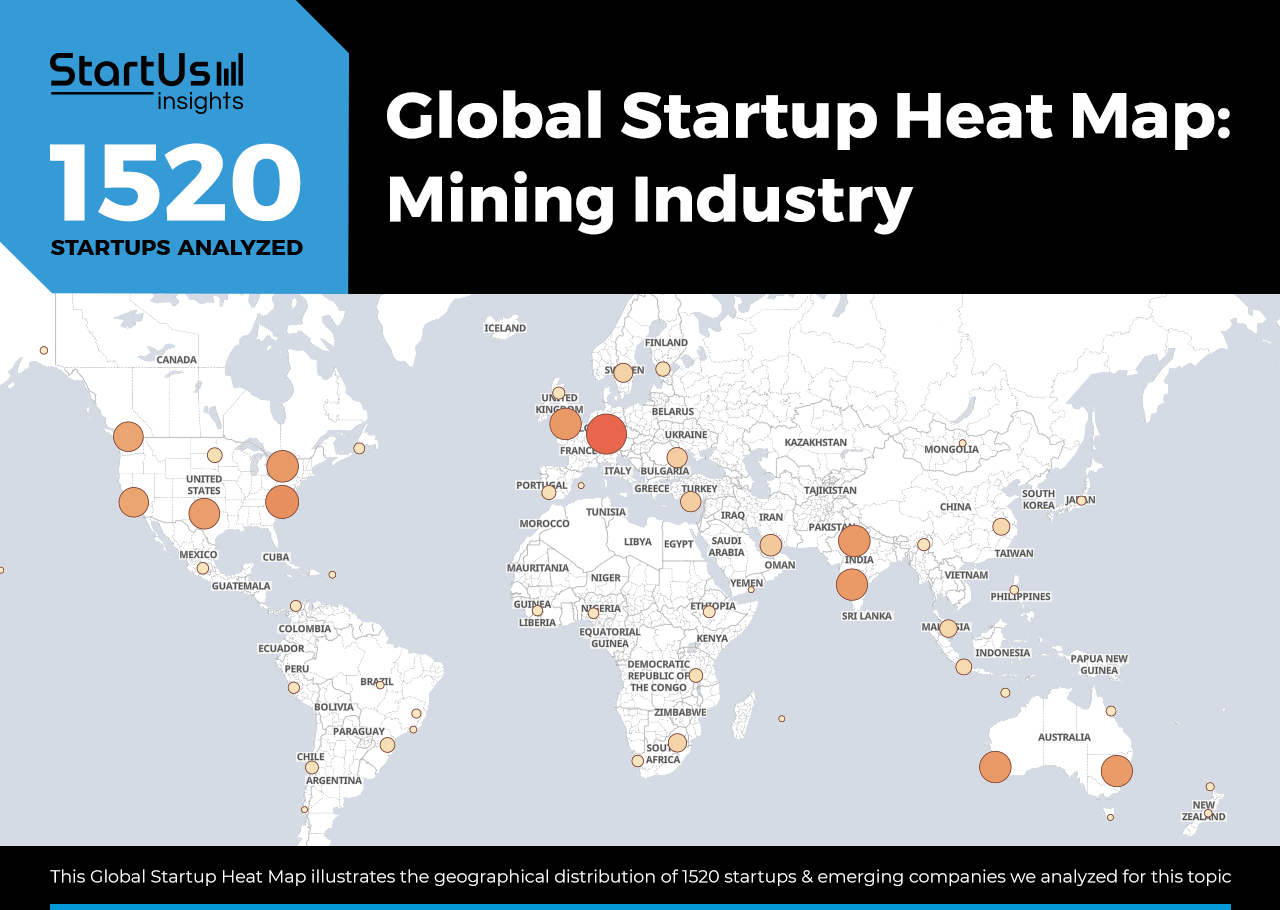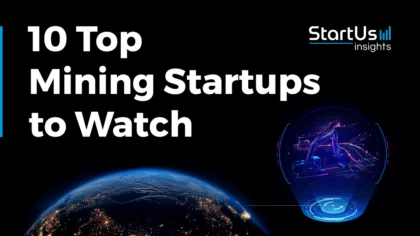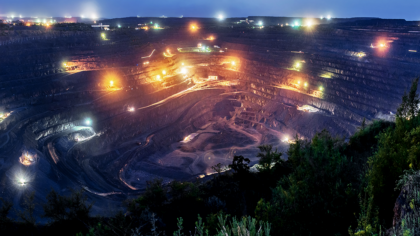Accelerate Productivity in 2025
Reignite Growth Despite the Global Slowdown
The mining industry is undergoing technological transformation to address critical challenges like resource scarcity, worker safety, operational inefficiency, and sustainable mining operations. AI and automation optimize drilling and blasting operations with real-time data analytics. For instance, Danish startup Innolidix integrates AI into mining activities that enable precise mapping of geological structures. The mining industry trends explore emerging areas like deep-sea and space mining, alongside IoT devices integration and compliance management. This report provides an overview of mining trends, ranging from sustainable mining and supply chain management to IoT integration and space mining. Read more to explore how they impact your business.
What are the Top 10 Mining Industry Trends in 2025?
- AI & Automation
- Critical Minerals Exploration
- Sustainable Mining
- IoT Integration
- Regulatory Compliance Management
- Supply Chain Management
- Space Mining
- Tackling Geopolitical Risks
- Health and Safety Innovations
- Deep-Sea Mining
Innovation Map outlines the Top Mining Industry Trends & 20 Promising Startups
For this in-depth research on the Top Mining Trends & Startups, we analyzed a sample of 1520 global startups & scaleups. This data-driven research provides innovation intelligence that helps you improve strategic decision-making by giving you an overview of emerging technologies in the mining industry. In the Mining Industry Innovation Map, you get a comprehensive overview of the innovation trends & startups that impact your company.
These insights are derived by working with our Big Data & Artificial Intelligence-powered StartUs Insights Discovery Platform, covering 4.7M+ startups & scaleups globally. As the world’s largest resource for data on emerging companies, the SaaS platform enables you to identify relevant technologies and industry trends quickly & exhaustively.

Tree Map reveals the Impact of the Top 10 current Trends in Mining (2025)
Based on the Mining Innovation Map, the TreeMap below illustrates the impact of the Top 10 Mining Trends in 2025. The major innovations in the mining sector focus on the integration of AI and automation to minimize human involvement in the exploration of critical minerals. Data-driven mineral extraction also reduces operational costs and increases the probability of the selection of the correct geography.
The need to address climate change brings in sustainable mining operations through electrification, zero-waste mining, and circular economy principles. Further, improving worker safety by aiding them with real-time training in the metaverse, simulated environments facilitates the confidence and health of mining operators. Emerging technologies like space mining and deep sea mining allow the exploration of geographies that have not been possible before and reduce the carbon emission associated with land mining.

Global Startup Heat Map covers 1520 Mining Startups & Scaleups
The Global Startup Heat Map below highlights the global distribution of the 1520 exemplary startups & scaleups that we analyzed for this research. Created through the StartUs Insights Discovery Platform, the Heat Map reveals high startup activity in Western Europe and the US, followed by Canada.
Below, you get to meet 20 out of these 1520 promising startups & scaleups as well as the solutions they develop. These mining startups are hand-picked based on criteria such as founding year, location, funding raised & more. Depending on your specific needs, your top picks might look entirely different.
Want to explore all mining innovations & trends?
Top 10 Emerging Mining Trends [2025 and Beyond]
1. AI & Automation
The mining industry faces challenges that include worker safety, hazardous environments, environmental impact, and equipment failures. AI and automation help to reduce human exposure to high-risk areas and dangerous environments. It deploys autonomous equipment for operations like drilling, blasting, and hauling which keeps workers away from dangerous areas. AI-driven monitoring systems predict equipment failures and minimize operational costs for maintenance. AI algorithms analyze large volumes of geological data, historical records, and satellite imagery to identify potential mineral deposits. Further, the integration of automation systems improves productivity and reduces human error in mining operations.
Ziraaf advances AI-based Mineral Exploration
US-based startup Ziraaf employs big data and AI to identify mineral deposits. Its solution combines geological data with AI and facilitates spatial analysis which has information like geophysical, geochemical data, and digital elevation models. The company’s patented AI model FALCON 360 allows data cleansing, quantifies the mineral deposits, and identifies hot spots through the understanding of geographic features. Also, it optimizes drill plans and estimates the 3D size and shape of deposits to enhance exploration efficiency.
Innolidix streamlines Mining Operations Automation
Danish startup Innolidix integrates AI into mining operations like drilling and blasting. It offers real-time mapping of geological structures and enables optimal drilling and blasting design with the fragmentation size of rock as input. The company’s AI algorithms collect key parameters from the mining site, process them, and increase work efficiency by delivering how much output each operation will deliver. This solution reduces downtime, carbon emissions, and costs by optimizing mining operations and increases employee safety.
Planetary AI enhances Mineral Exploration
UK-based startup Planetary AI utilizes artificial intelligence to optimize critical mineral and geothermal exploration processes. Xplore is the startup’s mineral prospectivity analysis software that enhances decision-making on the excavation of sites. It aids explorers in making proper decisions about mineral exploration for a region, country, or geological terrain. The platform offers geodata processing and integration capabilities than traditional systems and increases the discovery rate of critical minerals. Also, it develops pre-drill technologies that identify sub-surface characteristics and foster geothermal exploration.
2. Critical Minerals Exploration
Advancements in critical minerals exploration address the environmental challenges and supply chain risks of sourcing minerals like lithium, cobalt, and rare earth elements. Remote sensing and AI-powered location prospecting aid in mapping precise mineral deposits, which reduces the carbon footprint associated with excavation. The adoption of technology-driven exploration techniques eliminates the dependence on select countries that dominate mineral production. Companies also use digital twins to optimize mineral production and reduce equipment failures. Recycling technologies support the extraction of minerals like lithium from electronic wastes. This also addresses environmental concerns and promotes sustainable extraction methods.
Element3 simplifies Critical Mineral Extraction
US-based startup Element3 extracts lithium minerals from oil and gas wastewater. The startup makes use of waste products as a resource to address the needs domestic supply chain of critical minerals. It processes low-concentration brines to obtain high lithium recovery rates across large volumes. The company’s mining plants follow a skid approach that moves with resources and integrates into the existing oil-field operations and adjusts operations according to different pH and temperatures.
Beholder enables Mineral Deposit Prediction
Estonian startup Beholder develops a remote sensing platform for critical minerals and energy resources exploration. It utilizes AI and machine learning to process data from satellites and remote sensing identifies geological structures that indicate mineral deposits. The solution detects minerals through geological features, allows mapping of minerals, rare earth elements, and energy resources, and automates sustainability reporting. Key benefits of the platform include high spatial resolution, scalability, and cost efficiency that enables precise site mapping and reduced exploration risks.
3. Sustainable Mining
Sustainable Mining focuses on the adoption of mining techniques that minimize emissions, reduce resource depletion, and support safe operations. For example, renewable energy integration solutions address the carbon emission issues related to mining operations. Mining equipment and electric haul trucks powered by renewable energy sources reduce the reliance on diesel, minimize emissions and improve air quality.
Recycling of extracted minerals reduces environmental impact and promotes circular economy. The adoption of a circular economy in mining sites improves the recycling and reusing of extracted minerals to conserve resources and minimize environmental impact. Automated water management systems address the issue of excessive water consumption which minimizes freshwater use and addresses the scarcity concerns.
Iridsense develops a Multispectral Perception Solution
French startup Iridsense offers a multispectral perception solution that combines short wave infra-red (SWIR) spectral analysis with high-resolution LiDAR technology. The system delivers precise environment mapping in 3D and recognizes the chemical composition of the objects. LiDAR sensors emit their own light and support navigation inside the mining tunnel. The solution detects material properties up to 300 meters away, even in changing light conditions, and assesses the humidity and pollutant content in different types of rocks.
MEVCO offers Electric Fleets for Mining
US-based startup MEVCO offers light commercial electric vehicle solutions for the mining industry. It conducts research to prepare the site for EV deployments and monitors the amount and type of charging required. The startup performs the vehicle assessment to determine the best fit for the mining location. The company features two EVs Rivian R1T and MEVCO EV which have features like anti-locking brakes, airbags, and supports DC charging.
4. IoT Integration
The integration of IoT in the mining industry addresses challenges like unnecessary equipment downtime, high energy consumption, and worker safety. Sensors and connected devices provide real-time data on machinery, workers, and environmental conditions which improves performance and enables predictive maintenance. Implementation of IoT improves worker safety by tracking them in hazardous zones and limiting their exposure to accident-prone zones. Autonomous mining equipment like drilling and haul trucks optimize the excavation process and IoT-powered analytics provide insights for efficient resource extraction and processing. It drives a shift from reactive to predictive approaches in safety, maintenance, and decision-making.
Auyan facilitates Mining Downstream Process Monitoring
French startup Auyan offers a remote sensing platform for environment monitoring. It operates by integrating IoT and taking satellite images as inputs. It provides real-time tracking and assessment of water quality in downstream processing sites. Also, it provides insights into the progress of revegetation in mining sites to address the rehabilitation efforts. The platform offers automatic extraction of metrics from satellite imagery and in situ sensors that alert users to undesired events. The system monitors mining activities and shares relevant data to enhance worker safety.
JLTZ space integrates IoT for Mining Inspection
Mexican startup JLTZ Space provides geospatial intelligence for the mining industry through IoT integration. By utilizing satellite imagery, the startup connects assets on earth to detect the presence of minerals. It creates digital elevation models and allows monitoring of geological structures throughout the day and night. Through IoT, two-way communication is created that allows us to identify and measure different variables to monitor these assets. It facilitates remote monitoring of mining operations by synthetic aperture radar (SAR) and Normalized Difference Vegetation Index (NDVI) imaging.
5. Regulatory Compliance Management
Regulatory compliance management streamlines operations in mines and enhances safety standards by enhancing transparency, environmental protection and community engagement. Mining companies implement software systems to track and manage regulatory requirements and functionalities to track Environmental, Social, and Governance (ESG) criteria. These parameters are essential for earning social license to operate and secure a long-term project. Artificial intelligence solutions further enhance the predictive capabilities and allow companies to anticipate regulatory changes and adjust their operations. Blockchain-based solutions create immutable records of compliance activities which enhances transparency and trust with regulators and stakeholders.
Planckton streamlines Mining ESG Assessment
US-based startup Planckton Data offers regulatory reporting and certification compliance for the mining industry. The platform manages regulatory data, automates report collection, and derives insights about sustainability. The startup’s proprietary honeycomb model aids in emission management and sustainability planning in mining operations. It reduces the cost associated with maintaining compliance and monitors the change in real-time. Also, they support automated regulatory reporting and compliance programs for managing the carbon life cycle in the mining industry.
Offsetted simplifies Regulatory Compliance Reporting
German startup Offsetted develops a sustainability data management platform that aids in preparing regulatory reports in the mining industry. It monitors carbon footprint and understands ESG performance by creating a digital twin of mining operations. The platform reports progress in compliance by following recognized frameworks. It automates regulatory reporting for mining operations by integrating with existing software. Also, it fosters connections with the network of IoT partners for reducing emissions associated with mining.
6. Supply Chain Management
Mining companies adopt integrated supply chain management (SCM) solutions to ensure the delivery of minerals from remote mines to the processing plant. IoT-based monitoring systems support real-time visibility of supply chains and enable proactive modifications to inventory, logistics, and labor. Blockchain also enhances asset and payment management systems by ensuring secure data management throughout the supply chain. Further, robotic solutions enable consistent transport of raw materials from extraction sites to processing facilities while predictive analytics solutions allow businesses to anticipate demand and better plan logistics operations.
ReSource offers a Mineral Supply Chain Platform
Dutch startup ReSource offers a digital platform for mineral traceability and sustainable supply chains. The platform utilizes blockchain to track mineral resources from mines to supply units that manufacture electric vehicle batteries. It has a user-centric design that is adaptable to specific sites and fosters supply chain transparency. The platform also integrates a set of sustainable mining and sourcing standards and frameworks. The startup addresses the challenge of high costs for regulatory compliance and offers implementation support.
LisusEnergy improves Critical Mineral Supply Chain Management
US-based startup Lisus Energy provides a secure supply chain of critical minerals from mining companies to battery manufacturers. The startup utilizes deep learning and image processing to identify optimal locations for the mining of battery materials. The proprietary TRACE platform simplifies the supply chain by integrating geospatial analysis and tracking of material origins. It sources critical minerals like copper, lithium, and graphite for electric vehicle batteries. It partners with local suppliers and manufacturers to ensure a minimal environmental footprint for mining operations. This improves the supply chain management of critical minerals for high-performance batteries.
7. Space Mining
Traditional mining on earth leads to environmental degradation, air pollution, deforestation, and carbon emissions. On the other hand, space mining involves the extraction of minerals such as nickel, platinum, and rare earth elements from space bodies. They include asteroids, moons, and other celestial bodies. Space mining uses concentrated sunlight to drill holes in the asteroids and extract resources from them. Navigation of spacecraft and propulsion technologies reach and characterize asteroid mining targets. Specialized telescopes and survey techniques also enable the identification of resource-rich asteroids and address the challenge of low-gravity environments.
Starpath develops Rocket Propellant for Lunar Mining
US-based startup Starpath develops rocket propellant from raw materials on the moon to enable mining of Mars and the moon. It supports the refueling of launch vehicles with liquid oxygen and increases the earth-return capability. The startup’s solution includes three technologies – a fleet of mining rovers, a refinery, and a vertically deployable solar array. It addresses the challenge of refueling liquid oxygen and reduces the cost of transport to the moon by enabling landing vehicle reuse. This system also features a reusable architecture that allows vehicles to launch and re-launch on repeat.
Astroforge advances Critical Mineral Extraction from Asteroids
US-based startup Astroforge extracts valuable minerals by mining asteroids. The startup serves as an alternative to terrestrial mining and leaves no impact on the earth. It addresses the need for platinum group metals, which are essential for catalytic converters and clean energy solutions. Astroforge solution delivers multiple spacecraft deployments, starting with Brokk, which operates refinery technology in space. This is followed by Odin, which gathers critical imagery of target asteroids. The company’s third mission, Vestri, involves a production spacecraft designed to dock with a near-earth asteroid and begin extraction.
8. Tackling Geopolitical Risks
Mining companies adapt supply chain diversification and strategic partnerships to overcome risks related to politically unstable regions and regulatory adoptions. Flexible procurement strategies allow mining companies to reduce dependence on a single country and source critical parts of the supply chain near the location of operation. Scenario planning prepares them for location changes and trade restrictions using data analytics and predictive models. Miners involved in critical mineral projects also implement host government agreements (HGA) to protect their assets and ensure safety during sudden regulatory shifts. Remote monitoring of equipment, AI-driven decision-making, and automation further increase the flexibility of mining operations in geopolitically risky environments.
Common Good Mining fosters Sustainable Mining Operations
Canadian startup Common Good Mining addresses the geopolitical risks in the mining sector by partnering with local communities. It extracts critical minerals through economic-grade deposits with minimum impact on the environment. The company also focuses on projects with existing access and infrastructure with roads, power lines, port, and rail. The startup bridges the gap in mineral supply by establishing impact communities that facilitate the supply of critical minerals.
Woodcross Resources empowers Local Tin Production
Uganda-based startup Woodcross Resources offers sustainable mining practices. It develops an integrated tin production system that enhances the process from ore extraction to parts production. This solution enhances community development and minimizes environmental impact. The mining facilities present in the Ntungamo and Isingiro districts produce critical minerals, support local economic development, and create job opportunities. The startup ensures mineral traceability and ensures continuous supply of minerals.
9. Health and Safety Innovations
Mining operations involve the exposure of workers to hazardous terrain and risk-prone accident zones. The integration of AI, autonomous vehicles, and drones enables companies to navigate such environments. Augmented reality (AR)-enabled smart helmets project real-time data overlays, such as navigation guidance and toxic gas levels, into the worker’s field of view (FoV). Remote equipment monitoring also allows operators to control equipment from safe distances and reduce risks of accidents. Further, wearable sensors detect worker fatigue and gas levels to provide early warnings to mining professionals.
Gembapro develops Training Software for Mining Professionals
US-based startup Gembapro supports a safe and productive workplace for mining companies through interactive learning. By utilizing training software and digital twins, the startup creates engaging lessons about mining operations to improve worker skills. The software enables mining operators to assess their knowledge and hone their skills in a risk-free environment through the simulation of diverse tasks. It maintains training records and leverages modern equipment to enhance the worker output.
Minverso offers an Immersive Training Platform
Chilean startup Minverso provides metaverse-based training solutions for the mining industry. It creates virtual experiences of the mining operations that allow workers to practice procedures and protocols in a risk-free setting. The company’s platform enables remote collaboration and facilitates several operations like virtual inspection, maintenance, and more. This reduces risks in mining operations by enhancing the speed and retention of workers’ knowledge.
10. Deep-Sea Mining
Deep sea mining unlocks rich mineral reserves found on the ocean floor. It targets metals like copper, nickel, and cobalt, which are essential for batteries and renewable energy sources. Deep sea mining employs autonomous underwater vehicles (AUVs), remotely operated vehicles (ROVs), and subsea mining systems to extract resources. They withstand extreme pressures and by leveraging real-time monitoring, it limit sediment disruption and biodiversity loss. This improves supply chain security, provides an alternative source of critical minerals, and reduces the reliance on a small number of countries that dominate supply. Further, deep-sea mining addresses the challenges of traditional mining, which leads to deforestation, habitat destruction, and soil erosion.
Neomare focuses on Intelligent Sub-Sea Imaging
Norwegian startup Neomare provides subsea imaging solutions for deep-sea mineral exploration. It enhances offshore energy development by providing 3D-ultra high-definition images of sea bed and underlying structures. The company’s non-invasive image acquisition process identifies the location of near-surface minerals and offers better precision than traditional methods. This solution results in clearer insights and more informed decision-making for deep-sea mineral exploration projects.
Discover all Mining Trends, Technologies & Startups
The future of the mining industry aims at reducing energy use and the environmental impact related to traditional mining. Biomining extracts metals from ores or waste materials using microorganisms. Developments in 3D printing allow for the creation of mining structures such as shelters or temporary facilities. Further, technologies facilitating electrification, material repurposing, and zero-waste mining aim to reduce the environmental impact of mining.
The Mining Trends & Startups outlined in this report only scratch the surface of trends that we identified during our data-driven innovation & startup scouting process. Identifying new opportunities & emerging technologies to implement into your business goes a long way in gaining a competitive advantage.










